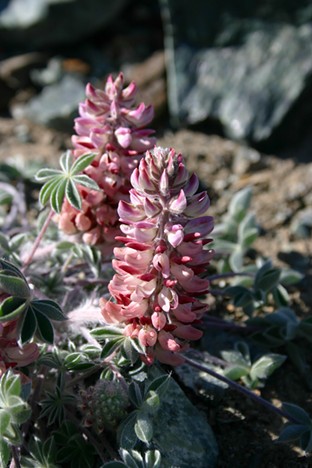Wednesday, January 20, 2016
Will the Lassics Lupine Survive?
Posted By Grant Scott-Goforth @GScottGoforth on Wed, Jan 20, 2016 at 11:25 AM
You're forgiven if this is the first time you've seen the Lassics lupine. The rare flower exists in less than four acres on Earth, on two small, alpine plots in southern Humboldt and Trinity counties. Climate change has dwindled the flower’s individual population to fewer than 60, scientists believe, prompting the Center for Biological Diversity to petition for emergency Endangered Species Act protections for the plant.
The little pink flowers grow on the talus slopes above 5,000 feet on Mount Lassic and Red Lassic Mountain in the Six Rivers National Forest, where wildfires last year tore through their native growing areas. It's unclear what specific measures can be taken to protect the plant, if it's indeed granted endangered species status.
The press release:
The little pink flowers grow on the talus slopes above 5,000 feet on Mount Lassic and Red Lassic Mountain in the Six Rivers National Forest, where wildfires last year tore through their native growing areas. It's unclear what specific measures can be taken to protect the plant, if it's indeed granted endangered species status.
The press release:
The Center for Biological Diversity joined two scientists and the California Native Plant Society today in filing a petition with the U.S. Fish and Wildlife Service seeking Endangered Species Act protection for the Lassics lupine, a rare alpine flower found in Humboldt and Trinity counties and nowhere else on Earth. There are only two known populations of the lupine, both growing above 5,000 feet elevation on the talus slopes of Mt. Lassic and Red Lassic Mountain, 80 miles southeast of Eureka. The pink flower’s total global range is less than four acres, and the total current population is estimated to be as few as 60 individuals.
“Without Endangered Species Act protection and recovery actions, we are at great risk of losing the Lassics lupine to extinction,” said David Imper, former plant ecologist for the Arcata office of the U.S. Fish and Wildlife Service. “Federal protection can’t come soon enough for this beautiful, imperiled flower.”
The Lassics lupine is threatened by climate change, altered fire regimes and predation by mammals. Both of the plant’s two remaining sites were harmed by the Lassics fire in summer 2015, and it is unknown how many individuals survived. Over the past 15 years the lupine’s range has been shrinking due to increasingly harsh conditions caused by decreasing rainfall, decreased snowpack and increasing temperatures. As conditions have become hotter and drier, predation on the flower’s seeds has increased. Small mammals have been documented eating nearly 90 percent of the lupine’s seeds.
“The plight of this gorgeous mountain lupine highlights the need to take urgent action to protect ourselves, and the other species we share the planet with, from catastrophic climate change,” said Tierra Curry, a senior scientist at the Center.
The Lassics lupine exhibits striking, pink-rose-tinged flowers above white-silver foliage, in sharp contrast to the surrounding black and reddish barren rocky slopes where it grows. It is dependent on sufficient snowpack and adequate shade to survive on the steep mountainsides. Both populations of the flower are found on the Six Rivers National Forest.
“Lassics lupine is a unique part of the natural heritage of California but it won’t be here for future generations if we don’t take immediate action to protect it,” said Greg Suba of the California Native Plant Society.
The plant was discovered in 1983. The Lassics Mountains were named after the Athapascan Lassik tribe, which was forcibly removed from the region in 1862. The species’ Latin name is Lupinus constancei, named for the famous California botanist Lincoln Constance.
“There is no better icon symbolizing the beauty and floristic diversity associated with the Lassics mountains than the Lassics lupine,” said Sydney Carothers, a botanist who has been studying the lupine for 15 years. “Hopefully the flower will continue to be a permanent representative of this truly exceptional landscape.”
The Center for Biological Diversity is a national, nonprofit conservation organization with more than 990,000 members and online activists dedicated to the protection of endangered species and wild places.
Speaking of...
-

Butterflies, Real Estate Mysteries and Pop-up Dining
Jan 26, 2024 -

Six Condors Now Fly Free Over Humboldt
Oct 11, 2022 -

Condor Release Attempt Set for Monday
Oct 7, 2022 - More »
Comments (3)
Showing 1-3 of 3
Readers also liked…
more from the author
-
Flamin' Hot's Stale Corporate Propaganda
- Jun 15, 2023
-
Hell is Visiting Other People
- Sep 22, 2022
-
The Bear Roars
- Aug 18, 2022
- More »

































